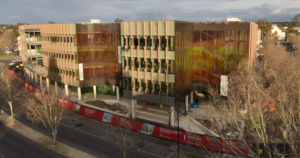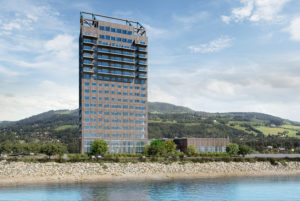When a material comes along that proves to be both fire-resistant and sustainable, the passive fire industry pays attention. The term “Cross-laminated Timber” is misleading in that it is a far superior material to its timber-frame cousins. Along with its ability to reduce greenhouse gases, one of the major advantages of cross-laminated timber is its inherent fire resistance. CLT can be designed to accommodate substantial fire resistance and unlike steel remains structurally stable when subjected to high temperatures.
Gaining traction in the Western building industry, CLT is also known as ‘mass timber’. It is already being employed in commercial construction projects across Europe. The world’s tallest timber building, Mjøstårnet in Norway, was entirely built using cross-laminated timber. What is truly innovative about this popular construction material is that CLT can be designed to withstand high temperatures and unlike steel, remains structurally stable when it heats up.
So why isn’t it being wholly embraced and spearheaded by the Australian construction industry? The issue lies with the testing. There is a big push in the industry for using CLT, but passive fire testing has not yet caught up when it comes to knowing the true limitations of this material. We know the official testing processes for concrete, steel and timber, but these methods cannot be directly applied to CLT.
Australian fire-safety laws are some of the strictest in the world, so while CLT is cost-effective and sustainable, there is still a debate about how to properly test its resistance to fire to our national rigorous standards.

PROFINISH Fire Protection contributed to the Bendigo Government Hub project featuring CLT.
The Fire Resistance of CLT
As we know, the measure of fire resistance (FR) is the time elapsed from the start of the fire until the point where the material fails to function. CLT’s fire resistance comes in the form of ‘charring’. When the timber is exposed to a fire that burns to a temperature in excess of 400 degrees C, the surface of the timber ignites and burns at a consistent rate. As it burns, it forms a black layer of ‘char’. This char is an insulating layer that prevents an excessive rise in temperature inside the core or ‘unburnt’ part of the panel. This core maintains its structure and continues to function for the period of fire resistance.
While the debate continues around the efficacy of the testing, CLT panels can be produced with an FR of 30, 60 and 90 minutes, so it is a certified fire-safe material. However, it isn’t as simple as just rating the CLT. If you have a project coming up that features CLT, you really need to consider where and how services will be penetrating, and if there are any FR requirements for the structural steel supporting the panels. These elements need to be protected collectively for the FR to be achieved.
With the use of CLT on any project, we are particularly vigilant when considering the FR of the supporting materials.

Mjøstårnet in Norway is the world’s tallest CLT building.
Does CLT need a fire-resistant coating?
In some instances, yes. While CLT is already a fire-resistant material, there may be contexts where it requires added materials such as coating or plasterboard for heavier protection.
How is CLT created?
CLT is an engineered wood product made up of layers of kiln-dried dimension lumber oriented at right angles to one another and then glued to form structural panels. By gluing the layers of wood at right angles, the panel delivers superior structural rigidity in both directions. CLT fabrication begins with lumber selection, defect removal and cutting, followed by adhesive application, panel lay-up, and assembly pressing. CLT panels are cut to size and quality control is carried out before delivery to the site. Unlike regular timber frames, panels can be used throughout an entire commercial building, replacing heavy steel or concrete.
On site, panels are hoisted into position and bolted together with metal brackets to build up the structure floor by floor. This method makes construction quicker and cleaner than traditional builds – yet another reason CLT is being favoured by more and more major builders.
Why is CLT considered green?
As timber is a renewable building material that stores carbon from the environment, CLT holds a green status. When compared to steel and concrete construction it is a lower impact material and therefore lower carbon footprint. As it has a quicker construction time than traditional methods, it uses less overall resources. It is also much lighter which allows for reduced slab and delivers a positive impact for project-wide embodied carbon totals. It is also a ‘clean’ product with much less waste, dust and noise produced brick or block work. Handling is also vastly reduced so it is favourable in terms of health and safety.
While cement and concrete are considered damaging to the environment due to the large amounts of energy and water needed in their production, they still remain prominent in Australian construction. Industry-wide change and reformation of build practices take time, but major developers including PROFINISH affiliate Lendlease are already incorporating CLT into builds. In Australia, existing examples of CLT towers are 25 King Street in Brisbane and the Docklands library in Melbourne.
Your passive fire protection experts
PROFINISH Fire Protection is dedicated to creating safer buildings in Australia. Please get in touch with one of our team members to discuss multi-system fireproofing packages for your major projects or high-profile developments. PROFINISH Fire Protection has worked on a range of projects featuring CLT including Bendigo Government Hub, Ballarat Government Hub and Lyndoch Primary Care Centre.
Sources
1. https://thefifthestate.com.au/innovation/materials/timber-building-is-on-the-rise-but-is-there-enough-and-is-it-safe/

